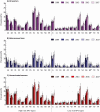Population Impact of Girls-Only Human Papillomavirus 16/18 Vaccination in The Netherlands: Cross-Protective and Second-Order Herd Effects
- PMID: 33249475
- PMCID: PMC7935392
- DOI: 10.1093/cid/ciaa1770
Population Impact of Girls-Only Human Papillomavirus 16/18 Vaccination in The Netherlands: Cross-Protective and Second-Order Herd Effects
Abstract
Background: Human papillomavirus (HPV) vaccination programs achieve substantial population-level impact, with effects extending beyond protection of vaccinated individuals. We assessed trends in HPV prevalence up to 8 years postvaccination among men and women in the Netherlands, where bivalent HPV vaccination, targeting HPV types 16/18, has been offered to (pre)adolescent girls since 2009 with moderate vaccination coverage.
Methods: We used data from the PASSYON study, a survey initiated in 2009 (prevaccination) and repeated biennially among 16- to 24-year-old visitors of sexual health centers. We studied genital HPV positivity from 2009 to 2017 among women, heterosexual men, and unvaccinated women using Poisson generalized estimating equation models, adjusted for individual- and population-level confounders. Trends were studied for 25 HPV types detected by the SPF10-LiPA25 platform.
Results: A total of 6354 women (64.7% self-reported unvaccinated) and 2414 heterosexual men were included. Percentual declines in vaccine types HPV-16/18 were observed for all women (12.6% per year [95% confidence interval {CI}, 10.6-14.5]), heterosexual men (13.0% per year [95% CI, 8.3-17.5]), and unvaccinated women (5.4% per year [95% CI, 2.9-7.8]). We observed significant declines in HPV-31 (all women and heterosexual men), HPV-45 (all women), and in all high-risk HPV types pooled (all women and heterosexual men). Significant increases were observed for HPV-56 (all women) and HPV-52 (unvaccinated women).
Conclusions: Our results provide evidence for first-order herd effects among heterosexual men against HPV-16/18 and cross-protective types. Additionally, we show second-order herd effects against vaccine types among unvaccinated women. These results are promising regarding population-level and clinical impact of girls-only bivalent HPV vaccination in a country with moderate vaccine uptake.
Keywords: HPV; herd immunity; human papillomavirus; population effects; type replacement; vaccination.
© The Author(s) 2020. Published by Oxford University Press for the Infectious Diseases Society of America.
Figures


References
-
- Qendri V, Schurink-Van ‘t Klooster TM, Bogaards JA, Berkhof J. Ten years of HPV vaccination in the Netherlands: current evidence and future challenges in HPV-related disease prevention. Expert Rev Vaccines 2018; 17:1093–104. - PubMed
-
- van Lier E, Oomen P, Giesbers H, et al. Vaccinatiegraad en jaarverslag Rijksvaccinatieprogramma Nederland 2018. Report No.: 2019-0015. Bilthoven, the Netherlands: National Institute for Public Health and the Environment, 2019.
-
- Woestenberg PJ, King AJ, van Benthem BHB, et al. ; Medical Microbiological Laboratories and the Public Health Services . Bivalent vaccine effectiveness against type-specific HPV positivity: evidence for cross-protection against oncogenic types among Dutch STI clinic visitors. J Infect Dis 2018; 217:213–22. - PMC - PubMed
-
- Donken R, King AJ, Bogaards JA, Woestenberg PJ, Meijer CJLM, de Melker HE. High effectiveness of the bivalent human papillomavirus (HPV) vaccine against incident and persistent HPV infections up to 6 years after vaccination in young Dutch women. J Infect Dis 2018; 217:1579–89. - PubMed

